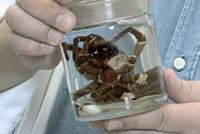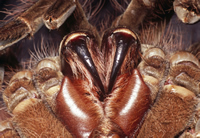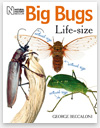World’s heaviest spider title challenged at Museum
Watch the video of the world spider heavy-weight title challenge that took place at the Natural History Museum. The contenders were the Hercules baboon spider and the Guinness World Records (GWR) holder for world’s heaviest spider, the Goliath bird-eater. Which emerged the champion?
Museum bug expert George Beccaloni was contacted by GWR life sciences consultant Karl Shuker after reports of a possible challenger to the world's heaviest spider record. Karl asked George if he could check the size of the Hercules baboon spider as the Natural History Museum has the world’s only known specimen and George is the author of the Museum book, Big Bugs Life-Size.

The Goliath bird-eating spider rarely eats birds but certainly is goliath in size. © George Beccaloni
GWR Editor-in-Chief Craig Glenday came in to adjudicate when George measured the two spiders. Using a jar of alcohol and the Archimedes' Principle, both specimens were submerged to discover the volume of alcohol they displaced, and therefore the volume of their bodies.
Spider specimens are stored in alcohol and this makes their internal organs shrink. The water inside them gets replaced by alcohol, which is about 25% lighter than water. This means that their weight when they were alive would be about 25% greater.
Knowing that they would weigh about 1g per cubic cm when alive means that their weights can easily be calculated if their body volumes are known.
Winning measurements
The female Goliath bird-eating spider specimen measured 69 cubic cm, more than double the volume and therefore the weight of the Hercules baboon spider that measured 22 cubic cm.
So the Goliath bird-eating spider remains the world's heaviest spider species, with the heaviest recorded individual being a 12-year-old captive female called Rosi - according to GWR, it had a body length of 119.4mm and weighed a massive 175g.
'Rosi was considerably heavier than the Museum specimen that we measured,' says George. 'It's amazing to think that she weighed about as much as 5.8 house sparrows!'

The Hercules baboon spider. This is the only known specimen and it is looked after by the Natural History Museum.
'People who have seen the Hercules baboon specimen, without a specimen of the Goliath bird-eater beside it, have been impressed by how huge it is and this has led to the myth that it might be the world's largest spider.'
Hercules baboon spider
The Hercules baboon spider, Hysterocrates hercules, specimen was collected over 100 years ago in Nigeria. Virtually nothing is known about this species but, in common with other baboon spiders, it probably lives in a burrow in the ground and comes out at night to hunt its prey.
Goliath bird-eating spider

The 2cm-long fangs of the Goliath bird-eating spider, probably the longest of any spider. © George Beccaloni
A lot more is known about the world champion, however, as it is commonly kept as an exotic pet. The Goliath bird-eating spider, Theraphosa blondi, is found in north-eastern South America, preferring wet mountain rainforest. It’s a nocturnal creature spending most of its time in a silk-lined burrow.
Despite its name, the spider doesn’t normally eat birds, but only because these are hard to catch! Its usual prey are crickets, beetles, small mammals, frogs and reptiles - basically anything smaller than itself.
Females are much larger than males and can live for 20 years, the males living only 3 to 6 years.
To warn off predators these spiders can make a hissing noise by rubbing together the bristles on their first 2 pairs of legs and pedipalps (front appendages).
Spiders around the world
Worldwide, there are over 40,000 known spider species and 850 of these are tarantulas. Spiders belong to the Class Arachnida that also includes ticks, mites, scorpions and others. The Museum has one of the largest arachnida collections in the world, used by researchers around the globe.
Other world records
At the Museum, George looks after the collection of Orthopteroid insects, a group that includes grasshoppers, crickets, cockroaches and stick-insects, including the world’s longest insect, Chans Megastick.
Toolbox
Big Bugs Life-size, new book

Enter a world of winged wonders, enormous earwigs and super-sized scorpions with Big Bugs Life-size.
It is the first book to feature life-size photographs of all the world’s largest and most spectacular bugs.